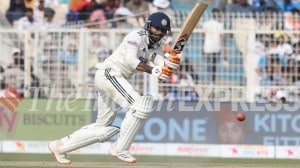Manas Srivastava leads the UPSC Essentials section of The Indian Express (digital). He majorly writes on UPSC, other competitive exams and education-related projects. In the past, Manas has represented India at the G-20 Youth Summit in Mexico. He is a former member of the Youth Council, GOI. A two-time topper/gold medallist in History (both in graduation and post-graduation) from Delhi University, he has mentored and taught UPSC aspirants for more than five years. His diverse role in The Indian Express consists of writing, editing, anchoring/ hosting, interviewing experts, and curating and simplifying news for the benefit of students. He hosts the YouTube talk show called ‘Art and Culture with Devdutt Pattanaik’ and a LIVE series on Instagram and YouTube called ‘LIVE with Manas’.His talks on ‘How to read a newspaper’ focus on newspaper reading as an essential habit for students. His articles and videos aim at finding solutions to the general queries of students and hence he believes in being students' editor, preparing them not just for any exam but helping them to become informed citizens. This is where he makes his teaching profession meet journalism. He is also the editor of UPSC Essentials' monthly magazine for the aspirants. He is a recipient of the Dip Chand Memorial Award, the Lala Ram Mohan Prize and Prof. Papiya Ghosh Memorial Prize for academic excellence. He was also awarded the University’s Post-Graduate Scholarship for pursuing M.A. in History where he chose to specialise in Ancient India due to his keen interest in Archaeology. He has also successfully completed a Certificate course on Women’s Studies by the Women’s Studies Development Centre, DU. As a part of N.S.S in the past, Manas has worked with national and international organisations and has shown keen interest and active participation in Social Service. He has led and been a part of projects involving areas such as gender sensitisation, persons with disability, helping slum dwellers, environment, adopting our heritage programme. He has also presented a case study on ‘Psychological stress among students’ at ICSQCC- Sri Lanka. As a compere for seminars and other events he likes to keep his orating hobby alive. His interests also lie in International Relations, Governance, Social issues, Essays and poetry. ... Read More
UPSC Essentials: One word a day – Marburg
What is Marburg? Otherwise a place, it is in news due to something very essential- Health. UPSC aspirants must know the word and connect it with other popular terms of the same category. Also, do not miss to solve the MCQ below.
 MVD is confirmed by lab testing of samples, which like Coronavirus and Ebola are extreme biohazard risks. (file image)
MVD is confirmed by lab testing of samples, which like Coronavirus and Ebola are extreme biohazard risks. (file image)
Take a look at the essential concepts, terms, and phenomena from the static and current parts of the UPSC-CSE. Also, check the answer to the previous MCQ.
Word: Marburg
Subject: Science, Health
(Relevance: In the age of pandemic, it is needless to say that diseases are potential questions. UPSC can mix up common facts with uncommon ones. Having a brief look will keep you prepared for difficult questions as well. Try to solve a general MCQ and ‘point to ponder’ below.)
Why in news?
— The first two cases of the Marburg virus disease, a highly infectious Ebola-like disease, have been confirmed officially by Ghana after test results were verified by a Senegal laboratory.
— This outbreak is only the second time that the disease has been detected in West Africa.
— It was first detected in 1967 after simultaneous outbreaks in Marburg and Frankfurt in Germany; and in Belgrade, Serbia.
— Due to its detection in Marburg, it got its name.
What is the Marburg virus disease?
— According to WHO, Marburg virus disease (MVD), is a severe, often fatal hemorrhagic fever.
— It was earlier known as Marburg haemorrhagic fever.
— Marburg, like Ebola, is a filovirus; and both diseases are clinically similar.
What are the hosts for the Marburg virus?
— Rousettus fruit bats are considered the natural hosts for the Marburg virus.
— According to WHO, African green monkeys imported from Uganda were the source of the first human infection.
— It was first detected in 1967 after simultaneous outbreaks in Marburg and Frankfurt in Germany; and in Belgrade, Serbia.
— The disease has an average fatality rate of around 50%.
— However, it can be as low as 24% or as high as 88% depending on virus strain and case management, says the WHO.
What are the challenges with Marburg virus disease?
— It is difficult to clinically distinguish MVD from diseases such as malaria, typhoid fever and other viral haemorrhagic fevers.
— However, it is confirmed by lab testing of samples, which like Coronavirus and Ebola are extreme biohazard risks.
— There is no approved antiviral treatment or vaccine for MVD as of now.
—I t can be managed with supportive care.
— According to the WHO, rehydration with oral or intravenous fluids, and treatment of specific symptoms can help prevent death.
Point to ponder: What is “disease management”?
MCQ:
Which of the following statement is/are correct?
1. The non-living characteristic of viruses is the ability to be crystallised.
2. Syphilis is a viral disease.
3. Marburg like Ebola is a filovirus.
a) 1, 2 and 3 b) 1 and 3
c) only 3 d) only 2
Answer to the previous MCQ:UPSC Essentials: One word a day – RCTs (d)
UPSC Magazine

Read UPSC Magazine
































